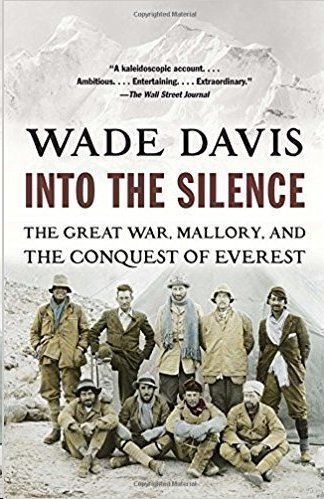"Into The Silence" by Wade Davis

Above: "Into The Silence - The Great War, Mallory, and the Conquest of Everest." Wade Davis. 573 Pages.
...to have this story documented to this level of detail is an important contribution to understanding the beginnings of Himalayan mountaineering and how the WWI experience of its participants helped to shape the overall effort.
I completed reading this book today.
I can see why The Zookeeper wanted me to read this book. He's a modern day version of those upper class, WWI survivors, who, rather than return to Britain to resume their post war lives, grasped on to a challenge to be the first to conquer the world's tallest mountain.
I've motorcycled with The Zookeeper in many far flung regions where our rides had taken on the aura of exploration and adventure. Alaska, Mongolia and Patagonia are the first three destinations which come to mind.
But, Zookeeper goes further. For discovering a new orchid species in Borneo, he was admitted to the New York explorers club. When he goes fishing, he goes to Patagonia, Kamchutka, or remote regions of Alaska.
So, he is not unlike our Everest seekers... most of whom, in their day, were affiliated with The Royal Geographical Society or the prestigious Alpine Club.
While The Zookeeper's recommendation would have been enough to read "Into the Silence," I was intrigued with the book's connection to WWI... a topic about which I have read considerably over the last two years... not to mention having recently traveled to WWI historical sites in Flanders and Gallipoli.
Author Davis makes clear that one can't appreciate the first attempts to climb Mt. Everest without first understanding how its would be conquerors were shaped in the crucible of the British WWI fighting in the trenches from 1914 to 1918.
20%, roughly, of the book chronicles the experiences of the would be Everest conquerors during war time. Most were officers, some were line commanders, and others were doctors. All experienced levels of carnage and death which at best numbed the senses and at worse rendered survivors dysfunctional when they returned to Britain after the war. There are almost thirty people who were key players either in organization of the Everest effort or actual participants in the expeditions themselves.
Narratives of famous battles, including Passchendale, Loos, Somme, and Arras are retold from the point of view of our later to be Everest seekers. All of these men kept diaries and/or wrote letters home. Davis, in an extraordinary research effort, has aggregated these war time experiences into a great personal history of WWI, if nothing else.
But, in the end, the book is about Everest.
From the heights of Darjeeling, the winter residence of the West Bengal British Raj, the Himalaya range could be seen to the north. At the height of the British Empire, around the turn of the 20th century, explorers and soldiers yearned to see those mountains up close. The route from the south through The Kingdom of Nepal was off limits. But, following the Bramahputra River course up to Tibet and then exploring the high country to the West was possible, thanks to strong relations between the British Presidency and the Delai Llama in Llasa, Tibet.
Davis, chronicles early explorations of Sikkim and lower Tibet, then tells the story of three British attempts, piggy backing on those early explorations, to climb Everest, in 1921, 1922, and 1924. None of the British expeditions resulted in reaching Everest's summit, but the expeditions, notwithstanding, laid the groundwork for success some 30 years later.
Men, whose previous mountaineering experience had been on rocky cliffs in Wales and the French Alps at max 14,000 feet. found themselves trekking over mountain passes at 17,000 feet just to get Everest base camp at 20,000 feet. Everest, itself, rises to 29,000 feet! How they survived at these elevations gives rise to discussions of supply chain management, cooking at high elevation, use of Yak dung for fuel, dealing with Tibetan porters, learning of the Buddhist lifestyle, and the efficacy of using Oxygen at higher elevation.
The Everest effort's key mountaineer, George Mallory, became an icon of mountaineering. He never returned from a final attempt, in 1924, to reach the summit. His body was only found in 1999 by a team of mountaineers who had undertaken a search to specifically locate his body and that of his co-climber, Sandy Irvine.
The book is detailed and requires concentration to read. Each day of three Everest expeditions is chronicled form the diaries/letters of all the participants. Without concentration, the events can blur. Notwithstanding, to have this story documented to this level of detail is an important contribution to understanding the beginnings of Himalayan mountaineering and how the WWI experience of its participants helped to shape the overall effort.
I enjoyed the book. I was particularly interested in reading about the passage of the Everest climbers through parts of India familiar to me... Calcutta, Siliguri, and Darjeeling. Within the last 18 months, TIMDT and Mwah (sic) have ridden sections of the Siliguri to Darjeeling cog railway, the same track used to upload expedition supplies to the launch off point for Tibet.